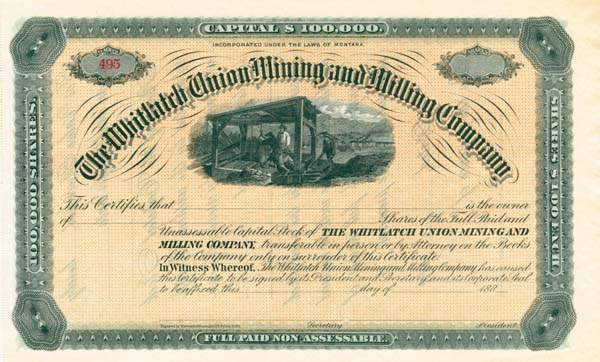Whitlatch Union Mining and Milling Co. - Stock Certificate
Inv# MS1230 Stock
State(s):
Montana
Years:
1880's
Scarce vignette engraved by Maverick & Wissinger, NY. Never seen issued. Rare!!
WHITLATCH-UNION MINE.
The Whitlatch-Union lode, discovered by James W. Whitlatch in September, 1864, is the oldest quartz discovery in the region. The lode was rapidly developed by several different mining companies, each of which owned but a short length, the longest piece being the 500 feet held by the Whitlatch-Union Mining Co. By 1872 the mine had produced $3,500,000, when it was shut down because of litigation. It has been operated intermittently since that tune and is stated to have yielded to date $6,000,000 in gold.
The mine was originally opened by a number of inclines, but with the exception of the Owyhee and Mclntyre they are all caved near the surface. Later a vertical shaft was put down to a depth of 500 feet. During 1911 some of the upper levels were accessible through the Owyhee incline, from which in recent years lessees have been getting out small shipments of ore.
The lode is situated 4 miles south of Helena on the summit of the low divide between Grizzly and Oro Fino gulches. It lies in the granite just south of the contact with the Quadrant quartzite. There occur scattered in the granite near the contact some huge blocks of highly metamorphosed sedimentary rocks, probably belonging to the Cretaceous formation shown on Weed's map.
The general course of the vein is N. 84° W.; the dip averages 45° N., but is subject to remarkable and abrupt changes, ranging from nearly horizontal to vertical. In width the vein ranged from a thin seam up to 15 feet, averaging about 4 feet. The ore taken out in early days averaged from $20 to $25 a ton in gold.1
As seen in the Owyhee incline the Whitlatch-Union vein is partly inclosed in hornfels and partly in granite. Abrupt changes in dip accompany the passage of the vein from the one rock to the other.
Statistics of mines and mining in the States and Territories west of the Rocky Mountains, 1869, p. 147.
A specimen taken from the footwall of the vein in the end of a drift driven west from the Owyhee incline is a dark heavy rock showing numerous small lustrous black flakes of biotite. When examined microscopically it is found to consist of a confused intergrowth of brown-green amphibole, biotite, and andesine, with accessory quartz. It is evidently a thermally metamorphosed rock, but further than this its origin is not apparent. It is possibly a recrystallized igneous rock. The locality from which this rock was taken is in the newest workings of the mine. The vein here is narrow, averaging 4 inches, and dips at a low angle to the north. The ore consists of pyrite and some quartz and is slightly oxidized. A small shipment running $70 a ton iu gold was taken out; unmixed with waste the ore runs $130 a ton.
A stock certificate is issued by businesses, usually companies. A stock is part of the permanent finance of a business. Normally, they are never repaid, and the investor can recover his/her money only by selling to another investor. Most stocks, or also called shares, earn dividends, at the business's discretion, depending on how well it has traded. A stockholder or shareholder is a part-owner of the business that issued the stock certificates.
Item ordered may not be exact piece shown. All original and authentic.










Ebay ID: labarre_galleries